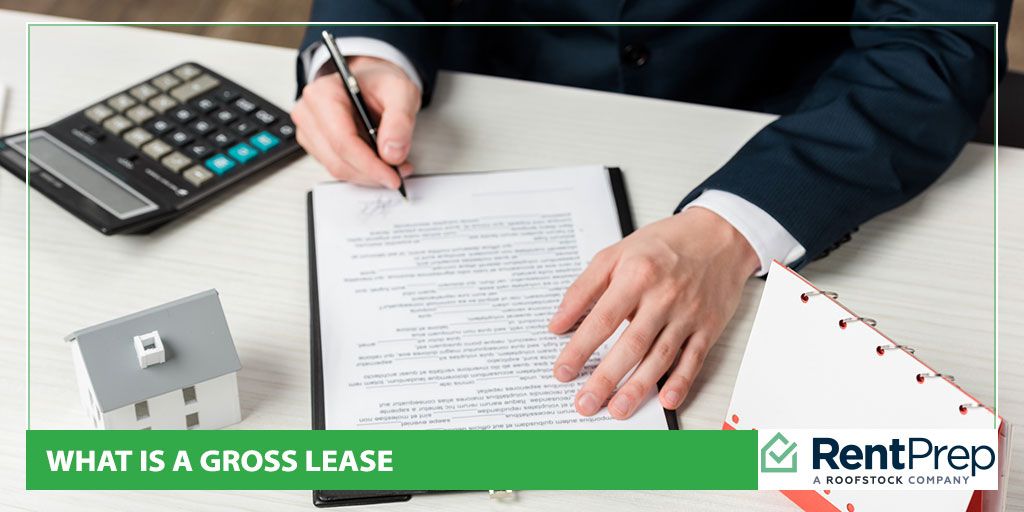
As a landlord, it’s common to use different types of leases. Understanding how each of those leases work, their intended uses, and what precautions to take is key to long-term success.
What is a gross lease in the real estate and rental business, and how can you utilize this lease type in your own business?
Using the wrong type of lease or not understanding what is entailed with a certain kind of contract can lead to missed opportunities, unhappy clients, and fewer profits. Do you feel confident in understanding gross lease types and how they affect your business?
Today, take a step back and review what a gross lease is, to ensure that this aspect of your business foundation is solid.
A Table Of Contents About Gross Leases
Gross leases are common, particularly in commercial real estate. How do they work, and what types of gross leases apply to your business? Learn more now:
- What Is A Gross Lease?
- Gross Lease Calculation: What’s Included?
- Gross Lease Meaning For Landlords: What You Need To Know
- FAQs: Gross Lease Definition And Meaning
- What Do Gross Leases Offer You?
What Is A Gross Lease?
Let’s start with the basic gross lease meaning: A gross lease is a type of agreement in which the tenant pays a flat rent to the landlord. In exchange, they get exclusive use of the property. The tenant is not responsible for any tax, utility, or insurance bills; they only pay the flat rental fee. The landlord covers all other expenses.
Gross leases are commonly used in commercial real estate and are heavily modified from lease to lease, so all needs are met by the contract’s terms. Modified gross leases are more flexible and add terms that reflect a specific building, rent increase schedule, or several other common points of potential conflict in a gross lease.
What Is A Gross Lease In Commercial Real Estate?

In commercial real estate, gross leases function as a way for landlords and tenants to have a simple payment plan agreement between them. Tenants enjoy gross leases because they do not take on the risk of fluctuating property taxes or utilities. Landlords are responsible for these costs but benefit from higher rent income associated with the increased risk.
Strip malls and commercial office buildings with multiple tenants often use this payment structure within their leases. Full-service leases cover everything, while other modified leases may require tenants to still pay certain fees. All lease terms should be reviewed carefully by both parties to ensure there is no confusion.
Types Of Gross Leases
There are two primary gross lease types: full-service and modified.
In a modified gross lease, the tenant pays the base rent, which includes most expenses. The landlord pays the additional fees. However, the specific terms of this lease may designate that the tenant will pay other parts of the additional expenses. In a retail space rental, for example, the modified gross lease may require the tenant to pay for repairs to a particular part of the property where they will be making changes.
With a full-service gross lease, the tenant pays one fee and the landlord covers all other costs. The landlord determines the rent based on the property’s overall monthly costs and the risk associated with the property. Due to this increased risk, full-service gross leases typically have higher base rental prices.
Gross Lease Calculation: What’s Included?
Gross leases are simple in execution since you only collect one fee each month, but calculating how much to charge for rent is more complex.
Landlords typically cover the following expenses in full-service leases:
- Property taxes
- Insurance fees
- Utilities, including electric and water
- Waste pickup
- Everyday building maintenance
Depending on the exact terms of your lease agreement, there may be several other expenses to manage. The rent charged to tenants should be enough to cover the operating costs of the property while still providing room for profit and growth.
Calculating rent should start with comparing similar property rental fees in the area, but don’t stop there. Work out how much expenses run on average and what amount of risk you’re carrying with those expenses. All should be balanced together to calculate monthly rent.
Gross Lease Meaning For Landlords: What You Need To Know
What are the key facets of a gross lease? Awareness of what factors are commonly seen in gross leases, modified or otherwise, will set you up for success when working with this type of agreement.
Included Expenses Vary
Setting up a commercial lease with tenants typically includes negotiation. For example, the actual expenses covered by the base rental fee can vary from agreement to agreement. Maintenance and property taxes are often the landlord’s responsibility, but there are some scenarios where both parties agree that the tenant will handle those payments.
Ensure that you and the tenant are on the same page about expenses and property liability as you work through your contract. Whether your final lease is heavily modified or set to be a full-service lease, everyone will be more comfortable once the details are reviewed.
Month-To-Month Variances

The amount you will pay on expenses each month will vary. Changing weather conditions, for example, will affect electricity, gas, and water bills. Some gross leases include clauses to increase rates variably based on these fluctuations, but most tenants prefer to keep a flat rate payment in the contract.
Make sure you think about these variations when calculating how much to charge for the base rate. You don’t want to just break even during months when the AC runs at a higher rate, so keep those variable costs in mind while calculating costs.
Rent Can Increase
Even though your gross lease agreement will set a base rent, that does not mean rent cannot be increased. Many gross lease terms include specific increments at which rent will be reevaluated to reflect cost variance and local inflation.
Consider adding terms to your gross lease agreements to cover how and when rent will be increased. Many gross leases include terms that tie the increased amount to a specific percentage alongside the most recent Consumer Price Index information. This ensures a fair and predictable change for both tenants and landlords.
Specific Terms Must Be Negotiated
You’ve likely noticed by now that there are sections of gross leases that need to be negotiated based on the specific situation. Expect to work out details with potential tenants when setting up a gross lease due to the wide variety of expenses that may or may not need to be covered.
Lease agreements often require specific negotiations about the following terms:
- Lease term length
- Lease rental fee
- Lease rental fee increase schedule and limits
- Included improvements and potential reimbursements
- Subleases
Be sure that you take time to work through every detail with tenants. It’s okay to be firm in your requirements for certain terms, but having flexibility with others may enable you to connect with great individuals who will become long-term tenants.
Securing Great Tenants
No matter what type of lease you use, finding great tenants to occupy your properties remains one of the most important parts of staying profitable. If your tenant screening process isn’t allowing you to find these great tenants, it’s time to get help.
Our mission at RentPrep is to simplify the tenant screening process for landlords like you while making screening more effective. Check out our tenant screening packages and gain access to high-quality tenant screening with excellent customer service.
FAQs: Gross Lease Definition And Meaning
Do you have lingering questions about gross leases and how they work? Check out the answers to questions frequently asked by landlords about gross leases.
What’s the difference between a gross and net lease?
Net leases and gross leases are two commonly used types of leases. While the two are nearly opposites, there are still some similarities.
As explained in today’s guide, a gross lease is one in which the tenant pays a flat rate fee for rent and isn’t expected to pay any additional expenses. The landlord covers utilities and building expenses. The costs are not directly passed on to the tenant but are covered by the flat-rate rent at the landlord’s discretion.
In a net lease, tenants typically pay a lower rate, but utilities and other expenses aren’t included in the rent. The tenant must pay these fees separately as the charges accrue.
There are different types of net leases. Commonly known as single, double, or triple net leases, the names indicate what other fees may need to be paid, such as property taxes, insurance, and maintenance.
What’s an example of a gross lease?
A typical example of a gross lease that most people are familiar with is a hotel rental. While this isn’t a traditional lease by any means, it does showcase a gross lease’s financial aspect.
When you rent a hotel room, you pay for the right to use the space for a specified period, including electricity, water, and other utilities within the unit. This is an example of “gross” use of the space.
Residential leases of buildings where you pay no utilities would be another example. If you have rented out a storage unit, you may have also experienced a gross lease during that process.
Who typically uses a gross lease?
Gross leases are most commonly seen in use with commercial properties. Owners of office buildings, retail spaces, and industrial spaces use gross leases with their tenants. While most residential rentals require the tenant to pay one or more of their utilities directly, some landlords prefer to use the gross lease approach.
There are no specific rules about who can and cannot use a gross lease. There may be legislation dictating how utility costs must be applied in a gross residential lease, but it’s up to you to determine which lease type works best for your properties and business.
What are the benefits of a gross lease?
In a gross lease, the amount of rent collected by a landlord is often higher than with other leases. This is because you, as the landlord, are taking on more risk than with other types of leases since you cover utilities and additional costs that can fluctuate. This means that you have a higher profit potential.
Additional benefits of a gross lease are predictability and simplified accounting. The exact rent is set for a more extended period than other lease types, and sometimes gross leases even spell out when increases will happen and how much the increase will be. This structure lets landlords and tenants know future profit and costs while keeping the accounting simple.
What is a 95% gross lease?
A 95% gross lease is a type of gross-up lease. In gross-up leases, the operating expenses included in the rent of the building are calculated as if the building is at 95-100% occupancy. Even if there is only one tenant, the rate charged for divisible expenses is set up as if the occupancy rate is near capacity.
What Do Gross Leases Offer You?
Gross leases are utilized in both commercial and residential real estate, though most of the more unique types of gross leases are limited to the commercial rental realm. Regardless of which sector you primarily work in, the deeper understanding you’ve gained of gross leases in today’s guide will benefit your business.
Remember that gross leases have many benefits for you and your tenants:
- Consistent payments that are more appealing to tenants
- Simplified accounting
- Pre-set increases that help plan for future growth
Overall, any particular lease’s success depends largely on the specifics. Always negotiate with your future tenants and adapt each lease to fit the specific arrangement. This will ensure you always know the details of your leases and that you set yourself up for future success.

